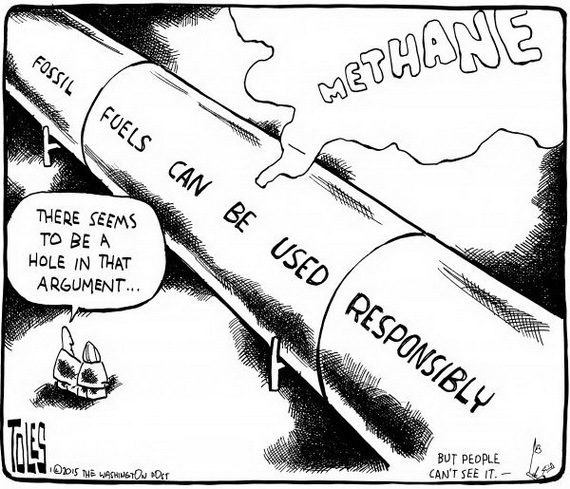Feature Image Credit Tom Toles at the Washington Post
by Louis Claxton
Originally published on ‘the Oxford Student’ website.
Since the target to limit global temperature rise to 2°C was set in the 2015 Paris Climate agreement, those in politics have focused their attention on the notorious and vilified CO2. But what about Methane?
There is no doubt that those in the scientific community have known about the efficiency of methane as a greenhouse gas for decades. A metric often used to illustrate methane’s efficiency is its global warming potential. This is the term used to quantitively express how effective a molecule of gas is at warming our planet in comparison to a molecule of CO21 . Indeed, methane is thought to have a global warming potential 33 times greater than CO2 over a 100-year time frame. The outlook is even more damning over 20 years, with methane calculated to have a global warming potential 105 times greater than CO21. The discrepancy between stating the 100-year and 20-year potency is in part due to the shorter residence time of methane in the atmosphere. The residence time is the length of time a molecule of gas is expected to remain in the atmosphere, being around 10 years for methane.

Whilst a shorter residence time may sound promising, figure 1 illustrates how the concentration of methane has changed in the atmosphere over the past 1000 years. Air collected and analysed from bubbles trapped in ice show that until the industrial revolution circa 1800 AD, atmospheric methane concentrations held stable at around 770 parts per billion (ppb). In the 200 years since, that number has risen to ~1850 ppb. Clearly methane’s short residence time is not enough to offset the sheer amount we are pumping into our atmosphere.
Moreover, this isn’t an easy problem to fix, as there is no real overall dominant cause for the rapid increase. Whilst anthropogenic emissions have increased, the contribution from a number of other notable sources including agriculture (both farm animals and rice paddy fields), forest fires and wetlands cannot be ignored2 . Methane is also one of the least regulated anthropogenically emitted greenhouse gases3 .
If we truly intend to meet the targets in the Paris agreement, then we better start paying more attention to methane. As the world warms and more methane is released due to the melting of the permafrost and other such positive feedbacks (processes caused by warming which in turn contribute to yet more warming), this issue will become even more prevalent.
Yet, there is another area, the usual scapegoat, in which regulations and policy must be implemented; the oil and gas industry. Poor practice in oil and gas operations currently leads to a whopping 76 million tonnes of methane released into the atmosphere annually by leaks alone4 . To put that in perspective, the U.K emitted 52 million tonnes in total in 20155 .
So where do we go from here? Well, Canada recently committed to reducing methane emissions by up to 45% by 20256 . Whilst this is a step in the right direction to reduce methane emissions, the largest methane emitter, China who in 2010 produced ~16 times as much methane as Canada7 , must follow suit.
1 Howarth, R.W., Santoro, R. and Ingraffea, A., 2011. Methane and the greenhouse-gas footprint of natural gas from shale formations. Climatic change, 106(4), p.679.
2 Schaefer, H., Fletcher, S.E.M., Veidt, C., Lassey, K.R., Brailsford, G.W., Bromley, T.M., Dlugokencky, E.J., Michel, S.E., Miller, J.B., Levin, I. and Lowe, D.C., 2016. A 21st-century shift from fossil-fuel to biogenic methane emissions indicated by 13CH4. Science, 352(6281), pp.80-84.
3 Vaughan, M., Zaelke, D., 27 April 2018. ‘Canada Takes the Lead on Methane Emissions’. Project Syndicate, https://www.project-syndicate.org/commentary/climate-change-managing-methane-emissions-by-scott-vaughan-and-durwood-zaelke-2018-04
4 International Energy Agency, 14 November 2017. ‘World Energy Outlook 2017’. International Energy Agency.
5 Department for Business, Energy and Industrial Strategy, 7 February 2017. ‘2015 UK GREENHOUSE GAS EMISSIONS, FINAL FIGURES’. Department for Business, Energy and Industrial Strategy.
6 Government of Alberta, 2018. ‘Reducing Methane Emissions’. Government of Alberta, https://www.alberta.ca/climate-methane-emissions.aspx
7 Kahraman, Z.. ‘Top 20 GHG Emitting Countries – Breakdown By Sector’. The Shift Project, http://www.tsp-data-portal.org/TOP-20-emitter-by-sector





